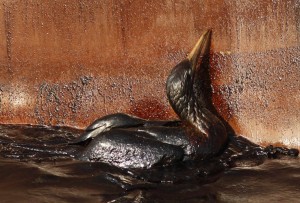Extent Of Oil Spill Damage Unclear
 The Wall Street Journal reports:
The Wall Street Journal reports:
A year after the worst oil spill to strike U.S. waters, oyster beds are struggling along the Gulf of Mexico, the dolphin population is experiencing what the federal government calls an "unusual mortality event," and red snapper with rotting fins are showing up on fishing lines.
But scientists say it's far too soon to make definitive conclusions about the scale and scope of the marine disturbances. This uncertainty, which may not be resolved for years, is paving the way for the next phase of the Deepwater Horizon disaster: an intense debate over the actual damage caused by the spill and who, if anyone, should pay.
In some instances, the cause of the damage is clear. Spots along the Gulf Coast still have oil from BP PLC's well lodged in tar-like "mats" under the water and buried in the sand on beaches, the federal government says.
Other cases are less clear-cut, and show how tough it can be to understand the interplay of an environmental disaster—even one so vast—with a complex ecosystem. While some dead dolphins are washing up with oil on them, for instance, the rise in deaths began before the spill.
The scientific effort to understand the spill's impact is one of the largest research projects of its kind ever. It is tackling questions of liability that might not be answered for years.
The government has named several companies in addition to BP as potentially liable for paying environmental damages. They include Transocean Ltd., which owned the drilling rig, and two owners of minority stakes in the well—Anadarko Petroleum Corp. and an arm of Japan's Mitsui & Co., MOEX Offshore 2007 LLC.
Lingering environmental problems are often less obvious than the spill's initial fallout, which left pelicans, beaches and miles of open sea coated in crude. But historically, the scope of a spill's damage sometimes emerges only years later, as oil settles in hard-to-see parts of the ecosystem.
"Dead animals floating in the water are not the biggest predictor" of a spill's ecological toll, says Andrew Whitehead, a Louisiana State University biologist. The focus now, he says, is on identifying long-term problems that "have big-time impacts."
A peer-reviewed study that included scientists from the National Oceanic and Atmospheric Administration found that fish embryos that survived oil exposure grew up as adults to swim slowly and have mild heart defects. Four decades after a 1969 spill in Buzzards Bay, Mass., scientists compared fiddler crabs in one marsh still tinged by oil to crabs in a nearby marsh that wasn't. They reported in a peer-reviewed paper that the crabs moved more slowly, and were present in only about half the density, in the oily marsh than in the untainted one.
The Deepwater Horizon spill began April 20, when the rig exploded above a BP well being drilled in mile-deep water. Over three months, 4.1 million barrels gushed into the sea.
That's as much as 16 times the oil spilled by the Valdez. Yet the amount of shoreline hit by BP oil was a fraction of the area doused in Alaska. The reason, government investigators say: The BP spill occurred deep underwater and far offshore, and officials fought to keep it at sea to protect the shoreline. However, it can be tougher to see the aftereffects offshore. Scientists are also studying the potential impact of widespread use of "dispersants"—chemicals sprayed on the oil to break it up.
Evaluating the spill is further complicated by the already compromised environment of the northern Gulf, an ecology strained by decades of coastal development, farm runoff and small oil spills. Despite that history, it still teems with so much life that scientists sometimes call it the "Fertile Crescent."
Federal law requires the U.S. government to document a spill's environmental damage—a process called a Natural Resource Damage Assessment—and requires companies found responsible to pay to fix the damage. If the government and the companies can't agree on a settlement, the fight can end up in court.
Click here to read more.

